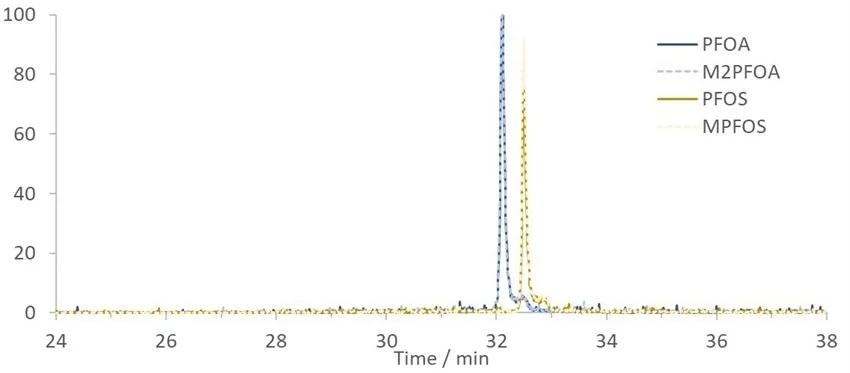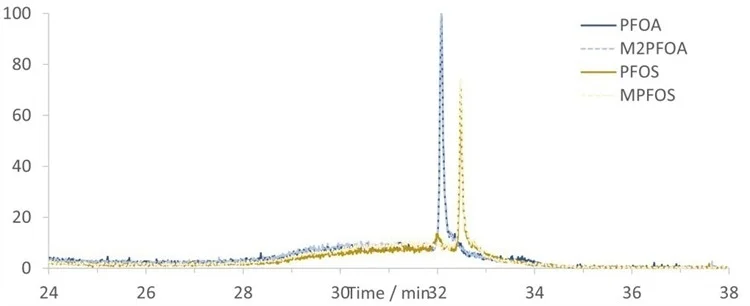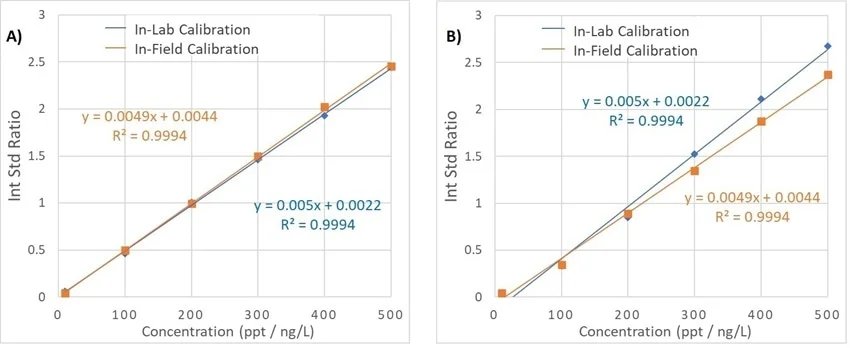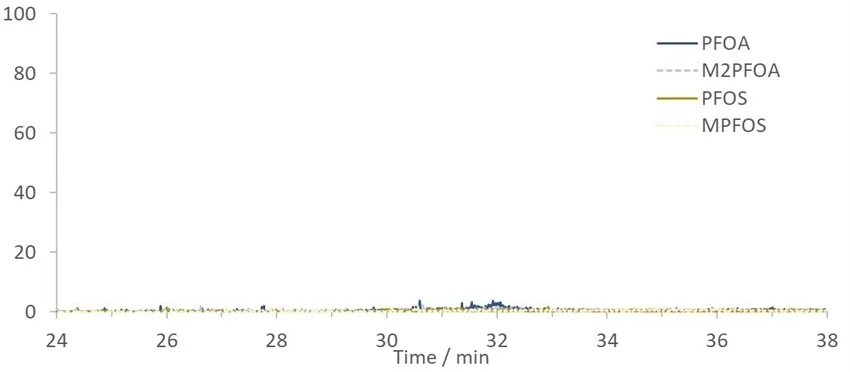The use of perfluorinated alkyl substances (PFAS), a type of man-made chemical, is popular in many applications, including non-stick cookware and waterproof coatings.
Sometimes referred to as “forever chemicals,”1 PFAS have a high resistance to degradation in the environment. This has led to the build-up of PFAS in various areas, such as in plants and animals (including humans), as well as in soils and water systems.2
There is increasing evidence that PFAS exposure can result in numerous adverse health effects, such as hormone disruption, effects on the immune system, low birth weights in infants, and cancer.1
Due to this, interest in measuring the levels of PFAS in environmental samples is increasing, but the current instrumentation and methods available are insufficient.
To tackle this, Microsaic Systems has created a method that involves a portable online solid phase extraction — liquid chromatography in combination with mass spectrometry (SPE-LC-MS) to bring the lab to the sample.
Experiment
An automated and online SPE and LC Pump System was utilized for the loading and separation of the PFAS samples, while Microsaic’s 4500 MiD® compact Mass Spectrometer was employed to detect the PFAS.
This SPE-LC-MS system was configured in two different formats:
- An in-laboratory set-up inside an air-conditioned laboratory that runs on mains power.
- A remote in-field set-up outside that runs on a generator with a maximum power output of 1.0 kW and an N2 bottle.
Table 1. SPE and LC conditions. Source: Microsaic Systems
| |
|
| SPE Cartridge |
Strata-X-AW 33 µm polymeric weak anion exchange 20 x 2.0 mm |
| LC Column |
Phenomonex Gemini 3 mm C18 110 Å 50 x 2 mm |
| LC Flow Rate |
0.3 ml/min |
| Column Temp. |
25 °C |
| Sample Volume |
50 ml |
| Mobile Phase A |
H2O + 0.4 % ammonium hydroxide |
| Mobile Phase B |
MeOH + 0.4 % ammonium hydroxide |
| Analysis Time |
38 min |
The LC gradient and the SPE run concurrently, although the sample is not eluted from the SPE until 22.15 minutes. This gradient remains at 90% B for the initial 10 minutes to prevent the accumulation of contaminant PFAS from the system.
The gradient is then brought to starting conditions before the elution to ensure equilibration of the column.
Water samples were collected in 250 ml polypropylene bottles and spiked with 200 ppt of PFAS standards and/or stable isotope-labeled internal standards. Following this, the samples were filtered using a 0.5 mm glass fiber filter and polypropylene syringes, with subsequent filtration using a 0.20 mm cellulose membrane filter.
After the samples are loaded onto the SPE cartridge, an automated wash step takes place. This is followed by a further wash step using the LC flow before elution of the PFAS takes place by increasing the amount of organic mobile phase.

Figure 1. Full system shown for the work presented. Left: Automated online SPE-LC pump system, Centre: Column thermostat, Right: Microsaic 4500 MiD® mass spectrometer. The resulting small footprint allows for it to be fully deployable and at the point-of-need. Image Credit: Microsaic Systems
Table 2. MS settings. Source: Microsaic Systems
| Scan mode |
SIM (Single Ion Monitoring) |
| Scan rate |
1 Hz |
| Step |
0.2 |
| SIM |
PFOA m/z 412.8,
M2PFOA (IS) m/z 414.8,
PFOS m/z 498.8,
MPFOS (IS) m/z 502.8 |
| Ion mode |
Negative |
| Gas flow |
1.5 l/min |
Results
The chromatographic separation between the samples of PFOA and PFOS did not change between the spiked HPLC water and the spiked canal water, as demonstrated in Figure 2 and Figure 3.

Figure 2. Chromatogram showing SIM traces of 200 ppt PFOA and PFOS standards in HPLC grade water with internal standards, M2PFOA and MPFOS, analyzed using the in-field setup. Image Credit: Microsaic Systems

Figure 3. Chromatogram showing SIM traces of 200 ppt PFOA and PFOS spiked canal water with internal standards, M2PFOA and MPFOS, analyzed using the in-field setup. Image Credit: Microsaic Systems
However, in the canal water samples, there was significant background noise from matrix components (see Figure 3), which demanded a wash step before elution from the SPE to shift the matrix components away from the PFAS peaks.
The chromatography for the samples analyzed in-field and in-lab was consistent, with no system contamination peaks observed, as shown in Figure 5.
Calibration curves were produced between 10 and 500 ppt with minimal deviation in the regression values and high recoveries for each spiked sample (see Figure 4).

Figure 4. Calibration curves for PFOA vs. M2PFOA (A) and PFOS vs. MPFOS (B). Each graph shows data for the calibration curve created in-lab (shown in blue) and using the in-field set-up (shown in orange.). Image Credit: Microsaic Systems

Figure 5. Blank chromatogram of HPLC grade water showing the lack of PFAS peaks from potential system contamination. Image Credit: Microsaic Systems
The calibration curves for the PFOA and PFOS were consistent across the in-field and the in-lab analysis, as displayed in Figure 4.
This permits the application of a calibration curve generated from in-lab conditions to samples that were analyzed in-field. This minimizes the number of samples that must be analyzed during remote work.
Standard recovery for the spiked canal water samples was within the range of 94% and 106%. The calculated concentrations were in agreement, as well as the standard recoveries, for the same samples that were analyzed in-lab and in-field.
Employing the online SPE-LC-MS method to analyze PFAS in water samples minimizes the amount of sample preparation that is required. The system has a low power consumption which enables the entire set-up to be run on a small generator.
The small footprint of the 4500 MiD® allows the entire system to be highly portable, fitting in the back of a car or van. No significant difference was observed in the results between the samples analyzed using the remote in-field set-up and a traditional lab-based set-up.
Conclusion
Using the Microsaic 4500 MiD® in combination with an automated online SPE-LC allows the first fully remote and automated on-site analysis of PFAS in water samples, with results equivalent to those achieved from lab-based set-ups.
Having these detection tools available at the point of need to analyze PFAS in water facilitates the monitoring of whole ecosystems and the mapping of these issues by geography and time.
References
- Sunderland, Elsie M., et al. "A review of the pathways of human exposure to poly-and perfluoroalkyl substances (PFASs) and present understanding of health effects." Journal of exposure science & environmental epidemiology 29.2 (2019): 131-147.
- Beans, Carolyn. "News Feature: How “forever chemicals” might impair the immune system." Proceedings of the National Academy of Sciences 118.15 (2021).
About Microsaic Systems
Founded in 2001, Microsaic Systems plc (AIM: MSYS) develops real-time, point-of-need mass spectrometers. Microsaic offers fast, accurate cutting-edge solutions to multiple industries across the world.
Core products, such as the compact MiD series of mass detectors, are designed to integrate seamlessly with a wide range of third-party OEM equipment or used as a standalone system. At the forefront of our design ethos is to deliver fast, easy to use, powerful mass spectrometry (MS) performance.
Patented chip-based MS technology and intuitive software enables real-time data generation at the point-of-need, not just in a centralised laboratory. Designed for both pharmaceutical and biopharmaceutical applications, continuous data is accessible at any stage of your workflow.
Over 20 years’ experience in mass spectrometry, microfluidics, vacuum systems, analytical processes, and miniaturised instrumentation has led to the development of our outsourced services. Laboratory, engineering, and monitoring issues can now be solved with a world-class team of chemists, physicists, and engineers by your side.
Sponsored Content Policy: News-Medical.net publishes articles and related content that may be derived from sources where we have existing commercial relationships, provided such content adds value to the core editorial ethos of News-Medical.Net which is to educate and inform site visitors interested in medical research, science, medical devices and treatments.